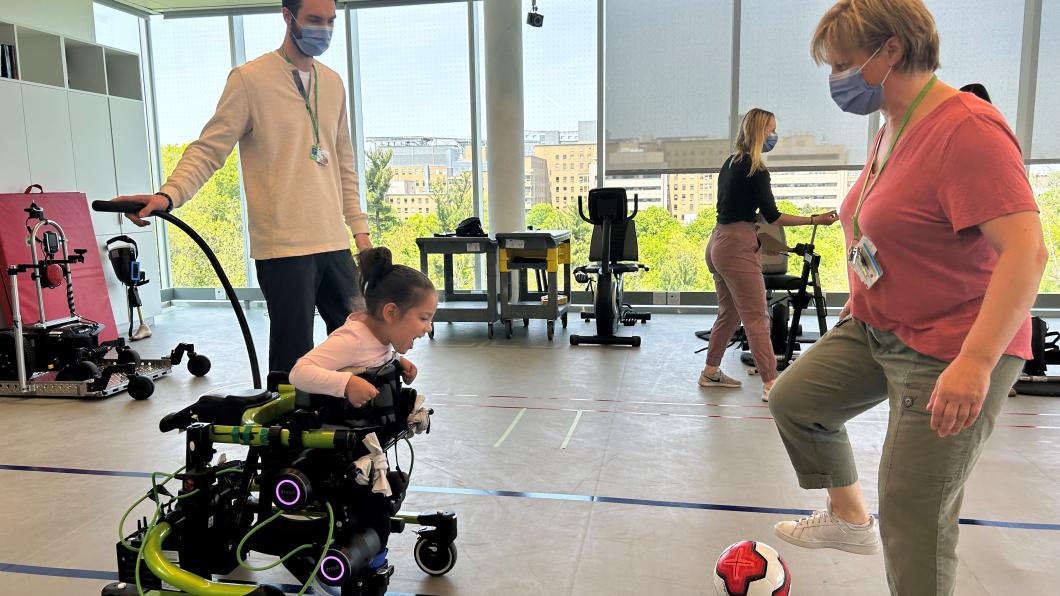
A robot helps children with cerebral palsy move in new ways
By Louise Kinross
For children with cerebral palsy and limited movement, walking in a walker can be exhausting, often painful, work.
The Trexo is a robotic frame that attaches to a walker and powers leg movements so children can experience comfortable, pain-free walking while using their body in new ways. Xio Rivero, then five (above), named it “the green machine.”
Researchers at Holland Bloorview are wrapping up a feasibility study that saw 10 children aged three to seven use the device twice a week for six weeks with a physiotherapist and physio assistant at the hospital and in its onsite school.
“The focus is not on walking itself, but on what the child gets from moving through space in an upright position,” says Stefanie Bradley, a PhD student in biomedical engineering and neuroscience leading the Trexo research.
While in the Trexo, kids kicked soccer balls, played basketball or catch with a Velcro ball and paddles, explored our accessible playground and did scavenger hunts and relay races. They also participated with peers at group stations during school gym class.
“Xio loved it,” says her mother Xochilt Palacios. “Because she can’t walk, it gave her a little bit more of the idea of walking and it gave her an experience she hadn’t had before.”
For one child, whose family were avid soccer fans, it meant playing soccer for the first time. “We set up goal posts in the gait lab upstairs and manifested a full game with teams!” Stefanie says.
“He went from saying ‘I’m not a sporty guy’ to ‘I want to play wheelchair soccer,” says Virginia Wright, a senior scientist and research team member who leads the Spark Lab at Holland Bloorview.
Using a maximum-support walker, kids “are putting all of their work and energy into keeping themselves up and huffing and puffing and consequently not conscious of the environment and the people and other fun stuff around them,” Virginia says.
Many children who benefit from the Trexo will continue to need a wheelchair to get around quickly and for long distances. The goal isn't necessarily to improve a child’s walking.
However, it does allow children to use their trunk, head, arms and hands in ways that aren’t possible in a wheelchair. “Not only are their legs facilitated to move, but you get more natural use of the total body, which is the best way to learn,” Virginia says.
Families and therapists set goals for how therapy with the Trexo would carry over into the child’s everyday life. Goals included sitting up on a couch for a certain amount of time, or while reading a book; using a spoon to eat; and sitting on the edge of the bed to help dress themselves.
“We saw the changes we hoped we would see to give evidence that the goals were accomplished,” Virginia says.
The Trexo proved a hit with each child. “The joy of that experience of getting to do fun stuff when they’re in it surprised me,” Stefanie says. “It was a huge confidence boost.”
For some kids it was the first time they’d been able to play with a toy while moving around. “One surprising observation is that kids are vocalizing more because they’re so happy and excited to engage in the world around them,” Stefanie says. Many families asked if they could do it again in future.
In addition to tracking changes in their everyday function, Stefanie will compare brain images and muscle and heart measurements of the children taken before and after the intervention.
The Trexo is expensive. Donors purchased the device in 2021 for $75,000.
In our model of motor-learning therapy, it is also labour intensive. One clinician engages the child in therapy while another controls the settings on the device, making it faster or slower and steering it.
The scientists are looking at how to incorporate this device, and a second one that is on order, into Holland Bloorview’s outpatient therapy program.
“We see this as providing life experiences at a time of peak neuroplasticity where exposure can maximize a child’s potential,” Virginia says. “We want to roll it out clinically here, and also develop standards of care for how it can be used in therapy here and elsewhere.”
The co-principal investigator on the Trexo study is Tom Chau, a distinguished senior scientist and former head of the Bloorview Research Institute who leads Holland Bloorview’s Prism Lab. Dr. Anne Kawamura is the physician investigator. Our main funders include the Cerebral Palsy Alliance Foundation and Holland Bloorview's Centre for Leadership Grant.
Several journal papers are in the works.
National Cerebral Palsy Day is celebrated in the United States on March 25. Like this story? Sign up for our monthly BLOOM e-letter, follow @LouiseKinross on Twitter, or watch our A Family Like Mine video series.